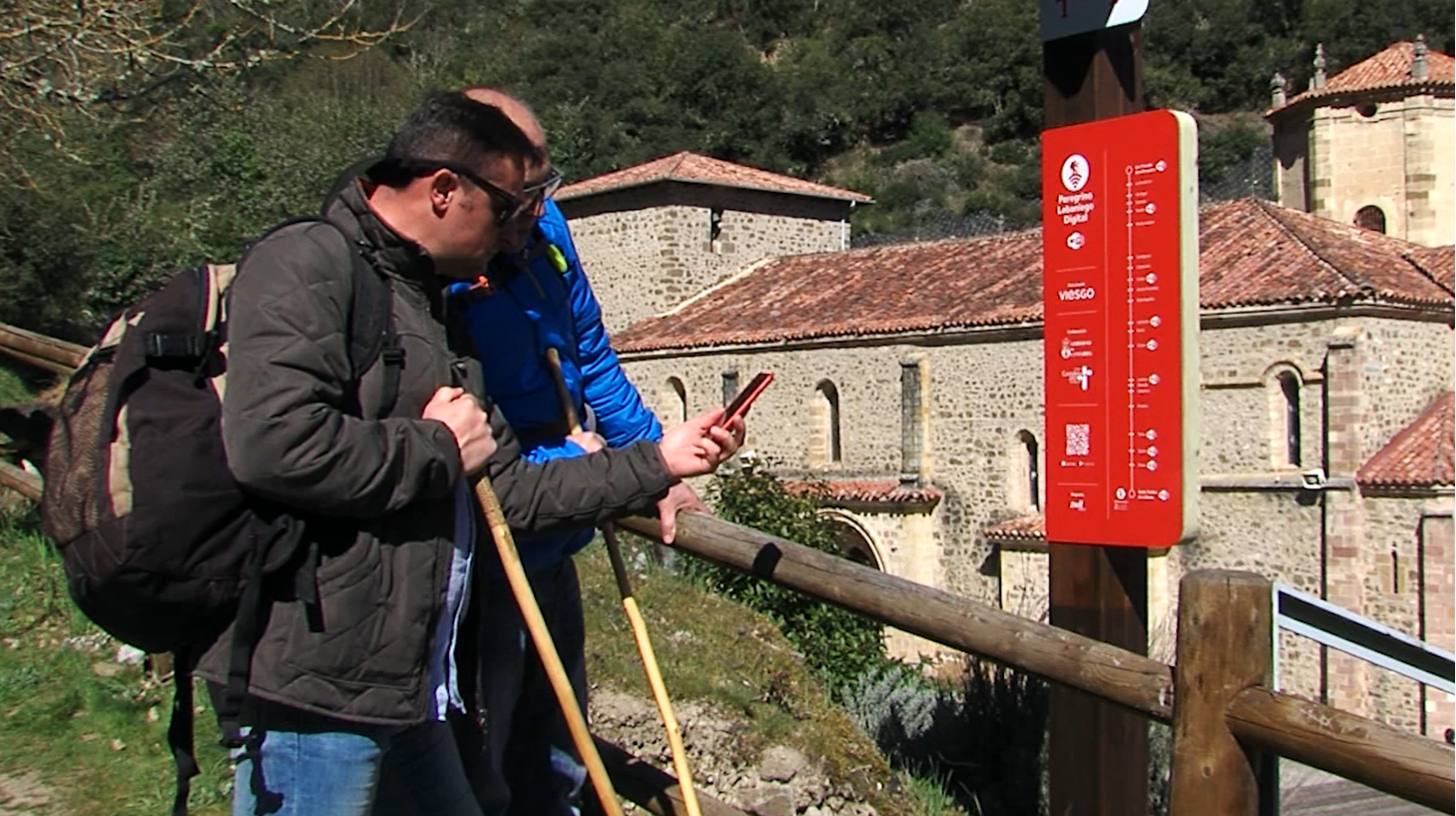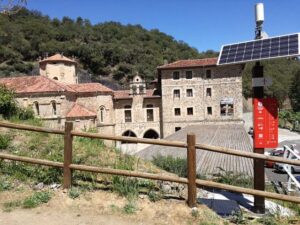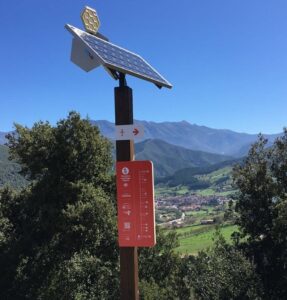
Two people walking in front of one of the 15 beacons of the Camino Lebaniego, in Spain.
Peregrino Lebaniego Digital 4.0 (Digital Lebaniego pilgrim 4.0) is a digital project launched in 2017 to revitalise the rural areas crossed by the Lebaniego Way, in the north of Spain, through the creation of an interconnected network of local businesses, pilgrims and tourists. Along the 72km of the Lebaniego route, hikers can find 15 beacons powered by solar panels that allow them to have free WiFi. In addition to this, pilgrims can download and app which provides them with a more personalised experience.
We have interviewed the CEO of Zwit Project and Territorio Rural Inteligente and finalist of our Religious Heritage Innovator of the Year 2022 Raúl Santos, to find out about the latest developments and the next stages in this ambitious and necessary project.
1. How did Peregrino Lebaniego Digital 4.0 begin and where did the inspiration come from?
The idea for this project was born approximately in 2016 when the regional government of Cantabria approached us with a challenge. In Zwit Project we have always been focused on the field of rural development, renewable energies and digitalization, so in view of the 2017 Camino Lebaniego Jubilee year, the government of Cantabria asked us for a long-lasting project with an impact that would last in the region beyond the Jubilee year.
In Zwit Project and in Territorio Rural Inteligente we began to think and we noticed that our rural environment needed more technological solutions that would help the towns and their people to be connected with each other and with the rest of the region. We then thought of applying the concept of “smart cities” to the rural environment. The Smart Cities projects that we saw at that time to get inspiration were always very large projects which had powerful technology firms behind them trying to sell their product. They were vertical projects, focusing on technology instead of people.
Using the smart cities concept as a start, we began to look for a connective thread that would allow us to transfer this trendy concept to a rural setting. And that connecting thread was the roads. Centuries ago, roads were the only routes of information. From the time of the Romans, the traveller was the one who, village by village, was telling the news that was happening. We came to the conclusion that in the 21st century what our roads in Cantabria need is the digital factor, for two things: driving sustainable development and approaching a new public, younger, more digital, and more avid to discover off-the-beaten-path sites.
We began to design the infrastructure we needed to bring digital coverage to the municipalities along the way and installed 15 beacons that run on sustainable energy, in this case, solar energy, and allow pilgrims and local people to have free Wi-Fi access. The beacons and information panels were complemented with an app to make the experience more immersive. Approximately 850,000 people have used the app since its launch in 2017.
2. How has this project benefited the local population and pilgrims?
Our project is based on four axes: connectivity, energy efficiency, sustainable development and competitiveness. When we started thinking about this project, connectivity in many of our rural areas was non-existent. Back in the day, fiber optic coverage wasn’t as widespread as it is today.
I remember when we first started putting up the solar-powered beacons, people looked at us sceptically, but eventually they started using them and benefiting from the coverage we offered through them. The key to success was that, in the end, people made this infrastructure their own, and they integrated it into their lives. We have never had a beacon vandalized.

Solar-powered beacon on the Camino Lebaniego.
Once the beacons were up and running we started to develop many things. We can now collect data on what visitors think of a place, whether we need to install more fountains on the trail, or whether we need to increase the capacity of pilgrim accommodations or open more recreation areas, restaurants, etc. It also makes the route easier for pilgrims, for example, if someone has a dog, they can consult the sites that the animal can enter and those that cannot or if someone is interested in a particular type of building they can search it on the app.
Technology should make our lives easier. The most important thing to boost the territory is that many people come, that the towns have to provide services to these people, create new infrastructures, new jobs, etc., and then that these people enjoy it and tell others about it.
3. Was it challenging to get all that infrastructure set up, making the Camino Lebaniego the first connected pilgrim route in the world?
Sometimes it is not a matter of resources, it is a matter of political will. A meeting that helped us a lot was one held by ICOMOS in Santander in 2016. Digital projects were still a bit scary back then because people thought it was going to mean replacing everything analogue. We tried to explain that what we were trying to do was not to do away with analogue but to support the growth of the region by adding a digital layer.
The Camino Lebaniego had recently been declared a World Heritage site. I tried to explain that what we wanted was to bring the Camino Lebaniego to more people and to promote the buildings, monuments and history of the region. And to manage them in an intelligent way by improving the connectivity of the towns.
Technology should be adapted to people’s needs. That is why sometimes, when I visit a rural area, I call the mayors of all the municipalities and on a blank sheet of paper we begin to “paint” the territory, to see what resources we have available to improve the well-being of the local population and also to attract visitors.
More often than not, we always find that something is missing and that something is connectivity. Rural development policies are usually thought of vertically, there is no principle of horizontality, and this often results in poor resource management. That is why it is important to always meet with people and listen to their problems and suggestions.
4. 2023 is the Lebaniego Jubilee year, an important year for the Camino Labaniego. Have you got anything new in the works? What are the next goals of the project in the long term?

Solar-powered beacon on the Camino Lebaniego.
Now that we have the structure of the project set up, our goal is to introduce small improvements or new functionalities whenever possible and to export our model to other territories.
We are always on the lookout for new funding calls, both national and European, that will allow us to introduce improvements. In Spain we have won six demographic challenge project calls and one tourism experience call with the model of Peregrino Lebaniego Digital 4.0. Now we aim to replicate this model in other territories. For example, we working on an Interreg SUDOE with France, Spain and Portugal to replicate our model and extend the connectivity of pilgrims’ routes on a larger scale. We have already established contacts in Portugal.
For the Lebaniego Jubilee year, which begins on 26 April, yes, there are new developments: we will open a smart pilgrim office and we will place sensors in several buildings so that people can access information about them. We will also relaunch our app, which has been under revision, with more resources and new functionalities, such as augmented reality, so that people can interact even more with the cultural heritage along the road and understand better their history and their meaning. Another step we want to take in the future is to make the app available in English and French.





Follow us: